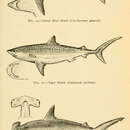Biology
provided by Arkive
Blue sharks are viviparous, giving birth to live young after a gestation period of nine to twelve months (6) (7). Up to 135 pups can be born per litter, partially depending on the size of the female, but the average is 25 to 50 (5) (6). Maturity is reached at approximately five to six years old and blue sharks are known to have lived to 20 years (7).
Although often observed cruising slowly and sluggishly the blue shark is capable of rapid movement if it is excited or feeding (6). This species will often circle its prey before moving in to attack it. Blue sharks primarily feed upon relatively small prey, such as bony fish and squid, but will also take larger prey including mammalian carrion (1).
Conservation
provided by Arkive
International obligations that regulate the fishing of sharks include the Code of Conduct for Responsible Fishing of the Food and Agriculture Organisation (FAO) of the United Nations, the International Plan of Action for Sharks (IPOA-SHARKS), the United Nations' Agreement on Straddling Stocks and Highly Migratory Species, and the Sustainable Fisheries Act. Although some countries have banned finning, there are no binding international treaties for the management of sharks, including the regulation or outlawing of finning (9). The blue shark is listed on Annex I of the 1982 Convention on the Law of the Sea (3), which stresses the need for international cooperation in the conservation, management and utilization of living aquatic resources, especially of migratory species. This does not, however, enforce any regulations (9). Fortunately, the blue shark is a prolific species with good rebound potential, and the abundance and wide distribution of this species offers a reasonable buffer against extinction (7).
Description
provided by Arkive
The blue shark is easily identified by its beautifully coloured slender body, which is a deep indigo-blue across the back, shading to a vibrant blue on the sides, and paling to white underneath (4). This shark has large eyes, triangular teeth, a conical snout, long pectoral fins and a second dorsal fin much smaller than the first (2) (4). While its elongated caudal fin provides swimming power, its sleek, tapered body makes it a graceful mover (5).
Habitat
provided by Arkive
The blue shark is a pelagic species occurring in the open ocean near the surface, inhabiting slightly deeper, cooler waters when in tropical environments (4). Although typically an offshore species, the blue shark may venture inshore, especially at night (1).
Range
provided by Arkive
Blue sharks are probably the most wide-ranging and (at least initially) one of the most abundant of all shark species, occurring in temperate and tropical waters from 50°N to 40°S around the globe (2). A migratory species, they periodically travel clockwise around the Atlantic, seemingly riding the Gulf Stream to Europe, taking various currents down the European and African coasts, and riding the Atlantic North Equatorial Current to the Caribbean region (1).
Status
provided by Arkive
Classified as Lower Risk / Near Threatened (LR/nt) on the IUCN Red List (1).
Threats
provided by Arkive
Although blue sharks are among the most abundant, widespread, fecund and faster growing of the sharks, they are one of the most heavily fished sharks in the world. With an estimated 10 to 20 million individuals caught and killed each year, there is concern not only about what this is doing to blue shark populations, but also about the effect the removal of such an important predator might be having on the oceanic ecosystem (1). Blue sharks are one of the most important species in the international shark fin trade. However, their meat, while eaten in a few countries, is not very popular (8). They are also an important angling species in some areas (1).

